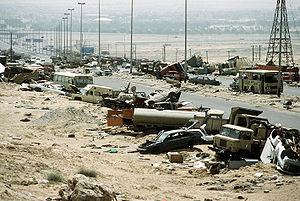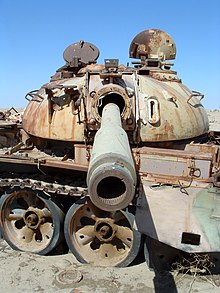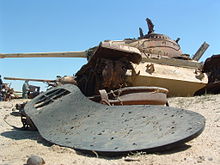Highway of Death: Difference between revisions
No edit summary |
No edit summary |
||
| Line 3: | Line 3: | ||
[[Image:Rusting_tank_at_the_Highway_of_Death_in_Iraq.jpg|thumb|right|A rusting tank at the Highway of Death, taken in February 2003]] |
[[Image:Rusting_tank_at_the_Highway_of_Death_in_Iraq.jpg|thumb|right|A rusting tank at the Highway of Death, taken in February 2003]] |
||
[[Image:Sole of shoe at Highway of Death in Iraq.JPG|thumb|right| |
[[Image:Sole of shoe at Highway of Death in Iraq.JPG|thumb|right|Remnants of the destruction on the Highway of Death.]] |
||
[[Image:Highwaygrave.jpg|thumb|right|The Highway of Death, Kuwait in 2005]] |
[[Image:Highwaygrave.jpg|thumb|right|The Highway of Death, Kuwait in 2005]] |
||
Revision as of 12:57, 19 September 2006



The Highway of Death refers to a road between Kuwait and Basra on which the retreating Iraqi army was attacked by American aircraft during the Gulf War, on the night of February 26/27, 1991. Western news reports refer to the road as Highway 80, and it runs from Kuwait City to the border towns of Abdali (Kuwait) and Safwan (Iraq), and then on to Basra. The road was repaired during the late 1990s, and was used in the initial stages of the 2003 invasion of Iraq by US and British forces in order to invade Iraq.
Attacks took place on two different sections; some 1,400 vehicles on the main highway north of Al Jahra and another 400 or so on the coastal road to Basra - the former predominantly stolen civilian vehicles and manned by Iraqi conscripts and the latter predominantly military and belonging to the Iraqi Republican Guard's 1st "Hammurabi" Armored Division. When visited by journalists the former was a long uninterrupted line of damaged and abandoned vehicles. On the other road, known as the place of the Battle of the Junkyard, vehicles of the had been destroyed over a much larger area in smaller groups, and the attacking Allied forces included ground units of the US 3rd Armored Division.
Controversy
The offensive action for which the road is infamous became a controversial point, with some commentators alleging that the use of force was disproportionate, that the Iraqi forces were retreating, and that the column included prisoners and civilian refugees. Although no reporters were present during the action, and media accounts did not appear for almost a month, photographs taken afterwards showed dramatic scenes of burned and broken vehicles. The bombings were cited by some observers as a war crime — the deliberate bombing of a stretch of highway where fleeing and "out of combat" Iraqi soldiers were stuck in a frenzied traffic jam.
The United States, however, cited that few Iraqi soldiers were found in the wreckage. According to a PBS Frontline interview with Rick Atkinson, when asked whether we know how many Iraqis were killed on the Highway of Death, he answered: "I don't think we'll ever know how many Iraqis were killed there. There were about 1,500 vehicles on the highway of death, counted, destroyed vehicles after the war. And another 400 or so on another road, a spur that ran parallel to the coast. Those who wandered through this wreckage right after the Iraqi surrender found relatively few bodies. Certainly some, and many that were terribly incinerated of those that were found. But the prevailing view is that many of the Iraqis had simply gotten out of their vehicles and ran. And it's difficult to believe that deaths on the highway of death probably exceeded more than a couple of hundred perhaps."
The Independent's Robert Fisk got there in the aftermath of the allied bombing. In his book "The Great War for Civilisation", Fisk describes the scene of kilometres of damaged military and civilian vehicles that was bombed as they were stuck in the traffic jam. He describes the burnt out remains of the occupants of the many vehicles. "I had seen hundreds of dead here; there must have been thousands. Shouldn't we have been referring back then, not to the highway of Death, but to the Massacre at the Mutla Ridge?"
Historic parallel
The attack mirrored an event in the latter half of the Second World War during the fighting in Normandy. German infantry, vehicles and tanks were confined in the Falaise pocket (or Falaise gap) by the Allies. As they tried to retreat, Allied ground attack aircraft heavily bombarded the trapped troops. Retreat turned to flight along what the Germans called the "death road" (Todesgang) between the villages of Chambois, Saint Lambert, Trun and Tournai-sur-Dives.
See also
- Jarhead (film), contains a scene of the Highway of Death
External links
- The Unseen Gulf War - A DigitalJournalist Multimedia Exposure by Peter Turnley
- PBS Frontline's "The Gulf War"
- An article in the Baltimore Sun, just before the second Gulf War, including a description of Highway 80
- An article in The Daily Telegraph, during the war, including a map
- An article in Stars and Stripes, contrasting the condition of the road in 1991 and 2003
- Photographs of destroyed military equipment taken by a contemporary American serviceman
- A high-resolution map of Kuwait. Highway 80 leads north from Kuwait city, via al-Jahra
- Clip from a CBC news broadcast depicting the incident's aftermath
